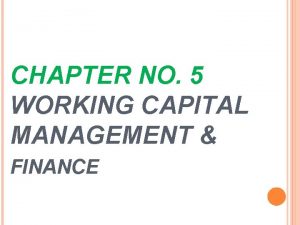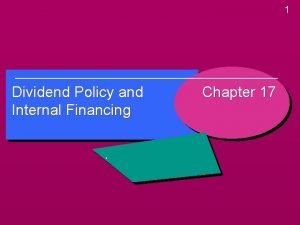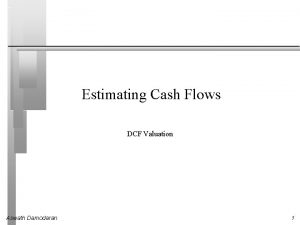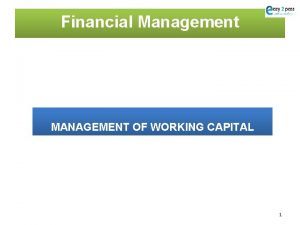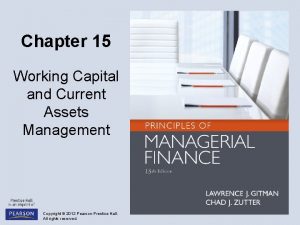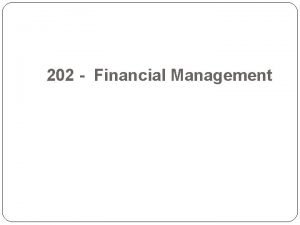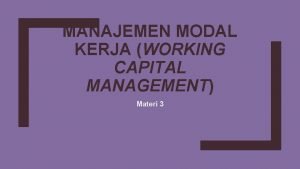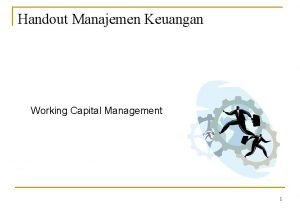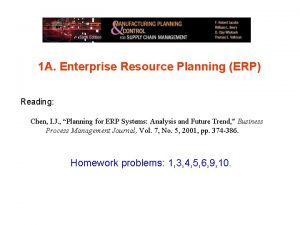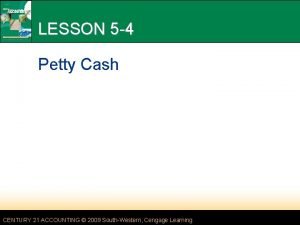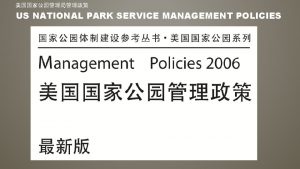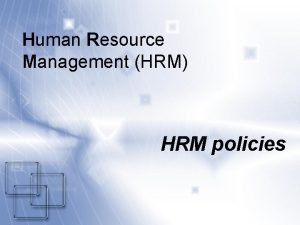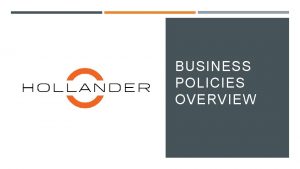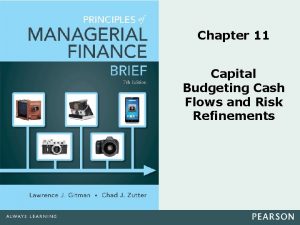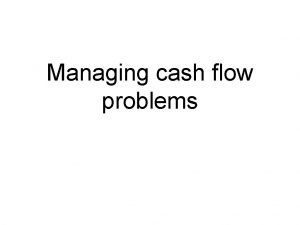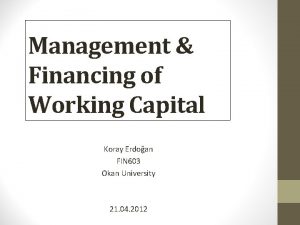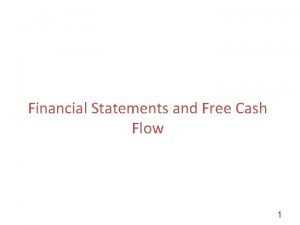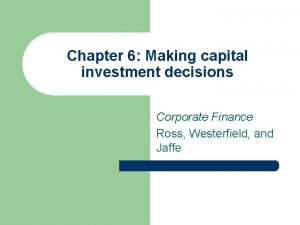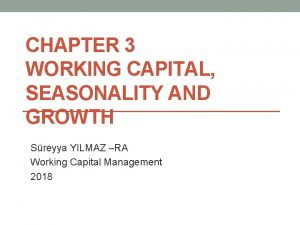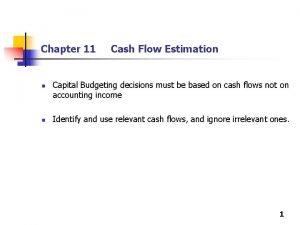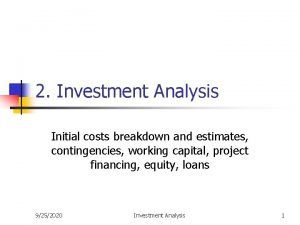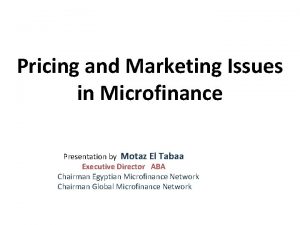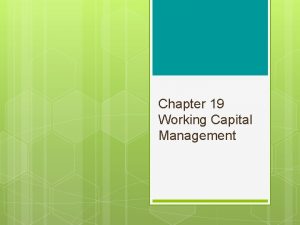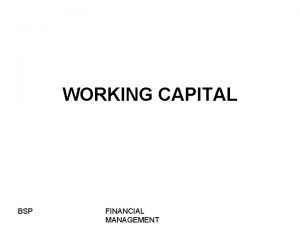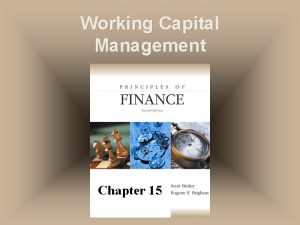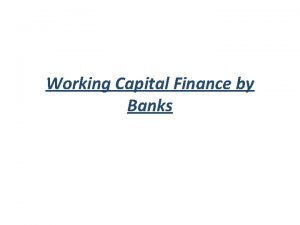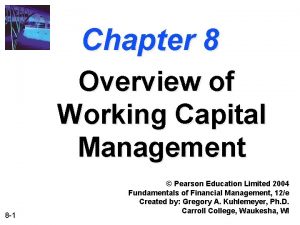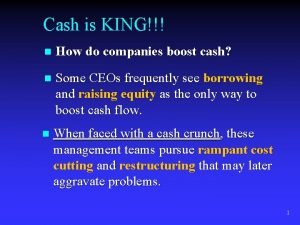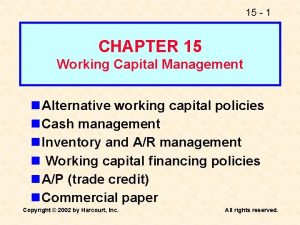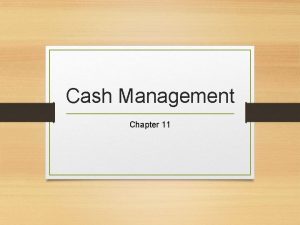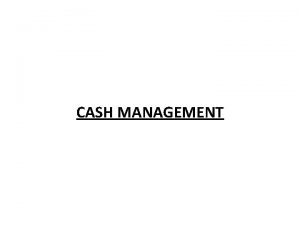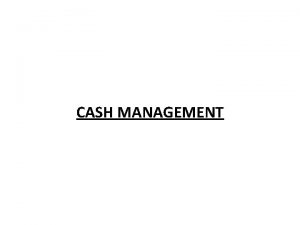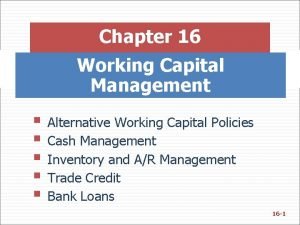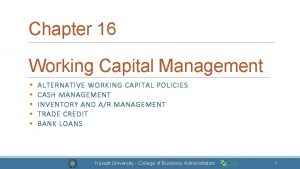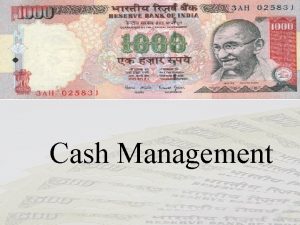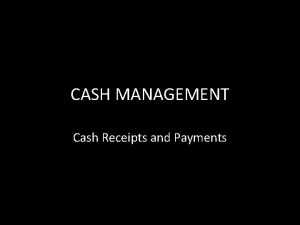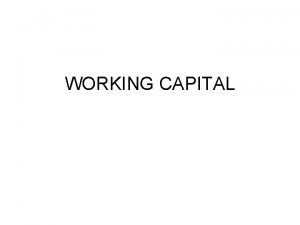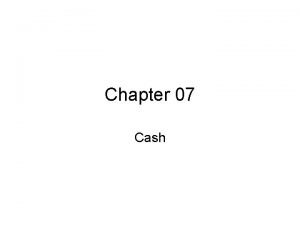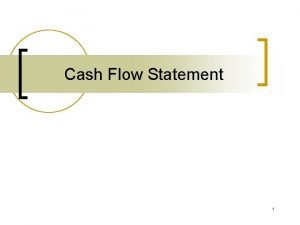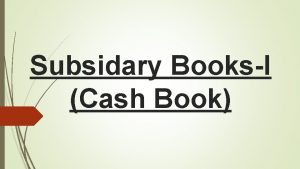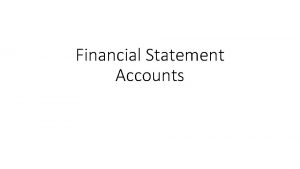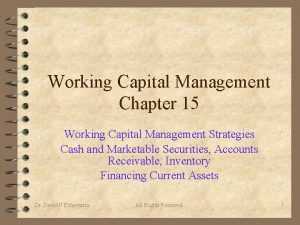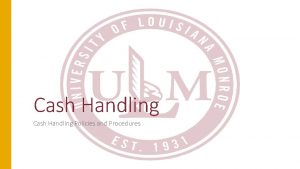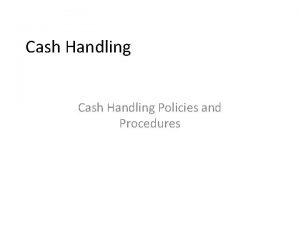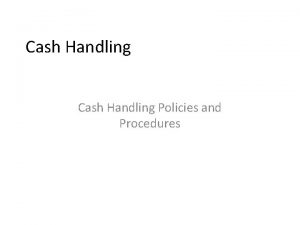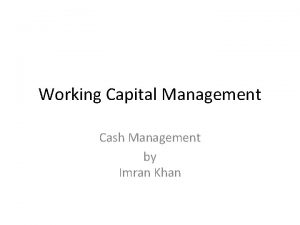Working Capital Management Alternative working capital policies Cash














































- Slides: 46

Working Capital Management Alternative working capital policies Cash, inventory, and A/R management Accounts payable management Short-term financing policies Bank debt

Strategic • Corporate Strategy • Business Strategy • Functional Strategy Financial • Selecting Investments • Raising the capital • Working Capital Management • Dividend Policy • Risk-hedging techniques Corporate Governance • Actions and policy of senior management • Performance measurement • Compensation systems • Investor communications

Basic Definitions • Gross working capital: Total current assets. • Net working capital: Current assets - Current liabilities. • Net operating working capital (NOWC): Operating CA – Operating CL = (Cash + Inv. + A/R) – (Accruals + A/P) (More…)

• Working capital management: Includes both establishing working capital policy and then the day-to-day control of cash, inventories, receivables, accruals, and accounts payable. • Working capital policy: • The level of each current asset. • How current assets are financed.

Selected Ratios for Stark’s Industry (STI) Current Quick Debt/Assets Turnover of cash DSO (365 -day basis) Inv. turnover F. A. turnover T. A. turnover Profit margin ROE Payables deferral STI 1. 75 x 0. 83 x 58. 76% 16. 67 x 45. 63 4. 82 x 11. 35 x 2. 08 x 2. 07% 10. 45% 30. 00 IND AVG 2. 25 x 1. 20 x 50. 00% 22. 22 x 32. 00 7. 00 x 12. 00 x 3. 50% 21. 00% 33. 00

How does STI’s working capital policy compare with the industry? • Working capital policy is reflected in a firm’s current ratio, quick ratio, turnover of cash and securities, inventory turnover, and DSO. • These ratios indicate STI has large amounts of working capital relative to its level of sales. Thus, STI is following a relaxed policy.

Is STI inefficient or just conservative? • A relaxed policy may be appropriate if it reduces risk more than profitability. • However, STI is much less profitable than the average firm in the industry. This suggests that the company probably has excessive working capital.

Cash Conversion Cycle The cash conversion cycle focuses on the time between payments made for materials and labor and payments received from sales: Cash Inventory Receivables Payables conversion = conversion + collection - deferral. cycle period

“How well a company efficiently manages noncash working capital”

Cash Conversion Cycle (Cont. ) Payables CCC = Days per year + Days sales – deferral Inv. turnover outstanding period 365 CCC = + 45. 6 – 30 4. 82 CCC = 75. 7 + 45. 6 – 30 CCC = 91. 3 days.

Cash Management: Cash doesn’t earn interest, so why hold it? n Transactions: Must have some cash to pay current bills. n Precaution: “Safety stock. ” But lessened by credit line and marketable securities. n Compensating balances: For loans and/or services provided. n Speculation: To take advantage of bargains, to take discounts, and so on. Reduced by credit line, marketable securities.

What’s the goal of cash management? • To have sufficient cash on hand to meet the needs listed on the previous slide. • However, since cash is a non-earning asset, to have not one dollar more.

• Increase forecast accuracy to reduce the need for a cash “safety stock. ” • Hold marketable securities instead of a cash “safety stock. ” • Negotiate a line of credit (also reduces need for a “safety stock”).

Cash Budget: The Primary Cash Management Tool • Purpose: Uses forecasts of cash inflows, outflows, and ending cash balances to predict loan needs and funds available for temporary investment. • Timing: Daily, weekly, or monthly, depending upon budget’s purpose. Monthly for annual planning, daily for actual cash management.

Data Required for Cash Budget 1. Sales forecast. 2. Information on collections delay. 3. Forecast of purchases and payment terms. 4. Forecast of cash expenses: wages, taxes, utilities, and so on. 5. Initial cash on hand. 6. Target cash balance.

STI’s Cash Budget for January and February Net Cash Inflows January February Collections $67, 651. 95 $62, 755. 40 Purchases 44, 603. 7536, 472. 65 Wages 6, 690. 56 5, 470. 90 Rent 2, 500. 00 Total payments $53, 794. 31 $44, 443. 55 Net CF $13, 857. 64 $18, 311. 85

Cash Budget (Continued) January Cash at start if no borrowing $ 3, 000. 00 $16, 857. 64 Net CF (p slide ) 13, 857. 64 18, 311. 85 Cumulative cash $16, 857. 64 $35, 169. 49 Less: target cash 1, 500. 00 February

How much should be the optimal cash? • Baumol Model: C = (2 FT/k)^1/2 Where, C = The optimal amount of cash you should hold F = Cost of providing cash (e. g. , from transactions) T = Demand of cash for a given period k = Opportunity cost or interest rate

Example • Manager of AA corp. forecasts the needs of cash for the next month $900, 000. The cost of converting marketable security to be cash is $500 in average. The rate of return is 12% per year. Calculate the optimal level of cash.

The minimum amount of cash 1. Compensating balances (a deposit held by a bank to compensate it for providing services) + 2. Precautionary balances (money held for emergency purposes) + 3. Transaction balances (money need to cover checks outstanding)

So. . Target cash = Optimal cash + Min cash Optimal Level Of cash Re-order point Plus Min level of cash Lead Time If you have cash more than the target , what should you do?


Should depreciation be explicitly included in the cash budget? • No. Depreciation is a noncash charge. Only cash payments and receipts appear on cash budget. • However, depreciation does affect taxes, which do appear in the cash budget.

STI’s forecasted cash budget indicates that the company’s cash holdings will exceed the targeted cash balance every month, except for October and November. • Cash budget indicates the company probably is holding too much cash. • STI could improve its EVA by either investing its excess cash in more productive assets or by paying it out to the firm’s shareholders.

Inventory Management

Inventory Management: Categories of Inventory Costs • Carrying Costs: Storage and handling costs, insurance, property taxes, depreciation, and obsolescence. • Ordering Costs: Cost of placing orders, shipping, and handling costs. • Costs of Running Short: Loss of sales, loss of customer goodwill, and the disruption of production schedules.

Is STI holding too much inventory? • STI’s inventory turnover (4. 82) is considerably lower than the industry average (7. 00). The firm is carrying a lot of inventory per dollar of sales. • By holding excessive inventory, the firm is increasing its operating costs which reduces its NOPAT. Moreover, the excess inventory must be financed, so EVA is further lowered.

If STI reduces its inventory, without adversely affecting sales, what effect will this have on its cash position? • Short run: Cash will increase as inventory purchases decline. • Long run: Company is likely to then take steps to reduce its cash holdings.

What Would Holding and Ordering Costs Look Like for the Years? EOQ Re-order point Lead Time A = Demand for the year Cp = Cost to place a single order Ch = Cost to hold one unit inventory for a year Plus safety factor Like 3 x demand Per day

Total Relevant* Cost (TRC) Yearly Holding Cost + Yearly Ordering Cost * “Relevant” because they are affected by the order quantity Q

Economic Order Quantity (EOQ)

EOQ Formula

Example Pam runs a mail-order business for gym equipment. Annual demand for the Trico. Flexers is 16, 000. The annual holding cost per unit is $2. 50 and the cost to place an order is $50. What is the economic order quantity?

Account Receivable Management

Accounts Receivable Management: Do STI’s customers pay more or less promptly than those of its competitors? • STI’s days’ sales outstanding (DSO) of 45. 6 days is well above the industry average (32 days). • STI’s customers are paying less promptly. • STI should consider tightening its credit policy to reduce its DSO.

Does STI face any risk if it tightens its credit policy? YES! A tighter credit policy may discourage sales. Some customers may choose to go elsewhere if they are pressured to pay their bills sooner.

If STI succeeds in reducing DSO without adversely affecting sales, what effect would this have on its cash position? • Short run: If customers pay sooner, this increases cash holdings. • Long run: Over time, the company would hopefully invest the cash in more productive assets, or pay it out to shareholders. Both of these actions would increase EVA.

What is trade credit? • Trade credit is credit furnished by a firm’s suppliers. • Trade credit is often the largest source of shortterm credit, especially for small firms. • Spontaneous, easy to get, but cost can be high.

Nominal Cost Formula, 1/10, net 40 Pays 1. 01% 12. 167 times per year.

Effective Annual Rate, 1/10, net 40 Periodic rate = 0. 01/0. 99 = 1. 01%. Periods/year = 365/(40 – 10) = 12. 1667. EAR = (1 + Periodic rate)n – 1. 0 = (1. 0101)12. 1667 – 1. 0 = 13. 01%.

Working Capital Financing Policies • Moderate: Match the maturity of the assets with the maturity of the financing. • Aggressive: Use short-term financing to finance permanent assets. • Conservative: Use permanent capital for permanent assets and temporary assets.

Moderate Financing Policy $ Temp. NOWC } Perm NOWC S-T Loans L-T Fin: Stock & Bonds, Fixed Assets Years Lower dashed line, more aggressive.

Conservative Financing Policy $ Marketable Securities Zero S-T debt Perm NOWC L-T Fin: Stock & Bonds Fixed Assets Years

What are the advantages of short-term debt vs. long-term debt? • Low cost-- yield curve usually slopes upward. • Can get funds relatively quickly. • Can repay without penalty.

What are the disadvantages of short-term debt vs. long-term debt? • Higher risk. The required repayment comes quicker, and the company may have trouble rolling over loans.

Treat suppliers as you would like customers to treat you. Far greater cash flow benefits can be realized by strategically leveraging your relationship with suppliers and customers. A supplier is more likely to support you in the case of emergency if you have treated them fairly, and, likewise, a customer will be willing to forgive a mistake if you have a strong working relationship
 Operating cycle method
Operating cycle method Constant dividend policy
Constant dividend policy Fcfe damodaran
Fcfe damodaran Introduction of working capital
Introduction of working capital Operating cycle formula
Operating cycle formula What is working capital in financial management
What is working capital in financial management Working capital and current assets management
Working capital and current assets management What is working capital in financial management
What is working capital in financial management Kebijakan moderat adalah
Kebijakan moderat adalah Mengelola keuangan
Mengelola keuangan Cash to cash cycle time
Cash to cash cycle time Cash to cash cycle time
Cash to cash cycle time Cash-in cash-out
Cash-in cash-out Disadvantages of master budget
Disadvantages of master budget Paid cash to establish a petty cash fund
Paid cash to establish a petty cash fund Paid cash to replenish the petty cash fund
Paid cash to replenish the petty cash fund Nps management policies
Nps management policies Human resource management policy
Human resource management policy Ebay business policy
Ebay business policy Capital budgeting
Capital budgeting Working smart vs working hard
Working smart vs working hard Hot working and cold working
Hot working and cold working Hot working and cold working difference
Hot working and cold working difference Machining operations
Machining operations Pembentukan logam
Pembentukan logam Ideal working capital turnover ratio
Ideal working capital turnover ratio Insufficient working capital results in
Insufficient working capital results in Nature of working capital
Nature of working capital Net operating working capital formula
Net operating working capital formula Equivalent annual cost method
Equivalent annual cost method Negative working capital
Negative working capital Operating net working capital formula
Operating net working capital formula Ocf formula
Ocf formula How to calculate incremental cash flows
How to calculate incremental cash flows Working capital breakdown
Working capital breakdown Working capital life cycle
Working capital life cycle Working capital ratio
Working capital ratio Working capital
Working capital Trade working capital
Trade working capital Bülent aybar
Bülent aybar Working capital managemetn
Working capital managemetn Working capital terminology
Working capital terminology Working capital finance by commercial banks
Working capital finance by commercial banks Working capital reporting
Working capital reporting Hedging approach of working capital
Hedging approach of working capital Boost working capital
Boost working capital Working capital financing policy
Working capital financing policy
